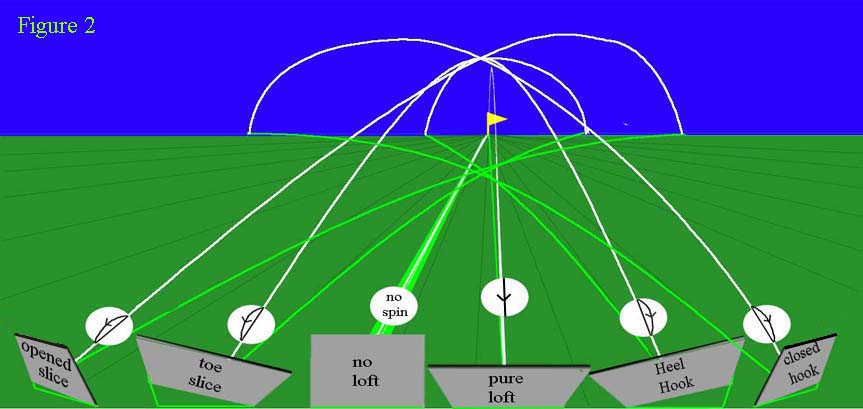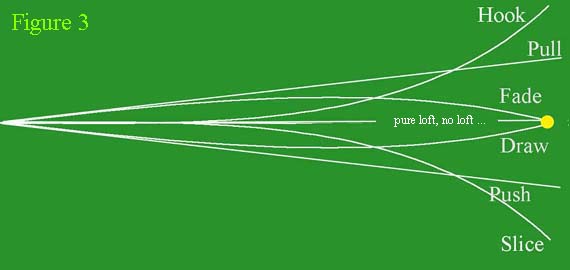 PHiLES home PHiLES home
|
| golf home |
| Bert Tells What He Reads |
| Greetings Home |
The Aerodynamics of Curves

|
|
|
 The spin of the ball causes the curve The spin makes the curve. The hot spot is the rear of the ball. Air
turbulence in the ball's little pits (that's why it has them) makes the ball move
against its rotation at the hot spot. There is some similar counter force at the
front side, but it is smaller so the hot spot force wins. If this would be a
side view then the ball has additional air support and wants to climb until the
energy is out. This rotation direction called below pure loft. |
The blade position makes the spin

In all six contacts the blade moves exactly to the flag. The white lines are the ball trajectories. The light green lines are on the ground, the vertical projections of the white lines.

In naming right curves "slices" and
left curves "draws" we assume what is called a "right handed" golf player, that is, a player
whose swing goes exactly like the double handed "backhand" of what is called a
"left handed" tennis player (whoever invented this terminology should indeed be
hanged).

Definitions
A. No curve
No loft (Figure 2): hit full swing with your putter, the ball mid feet.
Your ball goes over the grass, straight to the flag and will not spin.
Pure loft (Figure 2): hold a club with a lofting blade held to hit the ball exactly perpendicular
to the stroke's direction. Your ball goes up, will be sustained in
air by its purely vertical backward rotation (upward force) and head straight to the flag
A pull (Figure 3) is a straight shot left of target caused by out-to-in swing
(at contact the blade's direction is left of target).
A push (Figure 3) is a straight shot right of target caused by in-to-out
swing (at contact the blade's direction is right of target).
B. Curves left (hooks and draws)
Heel hook (Figure 2): when you stand far from the ball, your blade touches the
ball while on its heel and so the blade surface will not be perpendicular to the hitting direction
but fade out left (seen from player's side). The ball's backward rotation will be tilted left (left upward
force) and you'll hit a leftward curve. (Try it in table tennis!). You will also hit a
heel draw on an upward side slope. Adjust with a lower grip, or open your club, or
simply play the draw, adjusting your swing direction to right of target.
Heel draw (Figure 3): A heel
hook if played on purpose is called a heel draw: the player has
rotated himself to direct his blade right of target at contact. The ball will
initially head right of target then curve left to head and reach target.
Closed hook (Figure 2): when you close the club blade, it will, at contact, not be
perpendicular to the hitting direction but fade out left, just like in the heel
draw case. The ball's backward rotation will be tilted left (left upward force)
and will curve left.
Closed draw (Figure 3): A closed hook if played on purpose is called a closed draw: the player has rotated himself to direct his blade
right of target at contact. The ball will initially head right of target then
curve left to head and reach target.
C. Curves right (slices and fades)
Toe slice (Figure 2): .when you stand close to the ball, your
blade touches the ball while on its toe and so at contact will not be perpendicular to the
hitting direction but fade out right (seen from player's side). The ball's backward rotation will be
tilted right (right upward force) and will curve right. (Try it in table tennis!).
Toe fade (Figure 3): A toe slice if played on purpose is called a toe fade: the player
has rotated himself to direct his blade left of target at contact. The ball will
initially head left of target then curve right to head to target. You will also
hit a toe slice when you do not adjust on an downward side slope. Adjust by
extra knee bending, or close your club, or simply play the fade, adjusting your swing
direction to left of target.
Opened slice (Figure 2): when you open the club blade, it will
at contact not be perpendicular to the hitting direction but fade out right, just like in
the toe slice case. The ball's backward rotation will be tilted right (right
upward force) and will curve leftward.
Opened fade (Figure 3): An opened slice if played on purpose is
called a opened fade: the player has rotated himself to direct his
blade left of target at contact. The ball will initially head left of target
then curve right to head to target.
D: Combinations
Unfortunately the pure errors as defined above are rare. On the golf course,
you will no doubt have to face pulled hooks, pushed slices
and other frustrating combination errors. And you will occasionally be applauded
for landing proudly on the green with the
sliced pulls and hooked pushes that you are technically
obliged to
classify as failed shots.